New Delhi: Reserve Bank of India (RBI) Governor Shaktikanta Das on Sunday said he has tested positive for coronavirus and will work from isolation while the central bank will continue to function normally.
Das said he is asymptomatic and has alerted those who came in contact with him in recent days.
"I have tested COVID-19 positive. Asymptomatic. Feeling very much alright. Have alerted those who came in contact in recent days. Will continue to work from isolation. Work in RBI will go on normally. I am in touch with all Dy. Govs and other officers through VC and telephone," he tweeted.
Currently, the RBI has full strength of four deputy governors -- BP Kanungo, MK Jain, MD Patra and M Rajeshwar Rao.
The RBI governor, 63, has been quite active during the lockdown period and post unlock period to keep the economy and financial market in good shape.
He used both conventional and unconventional monetary policy tools to support economic recovery hit by COVID-19 crisis.
Last week, Das said the country is at the doorstep of economic revival on the back of accommodative monetary and fiscal policies being pursued by the central bank and the government.
We are almost at the doorstep of revival process and it's very important that the financial entities have adequate capital (to support growth), he had said.
On Friday, the Governor chaired the 585th central board of RBI meeting via video conference to discuss, among other things, the economic situation and other challenges.
The number of new cases of COVID-19 in India has come down from over 90,000 to about 50,000. The country's COVID-19 caseload mounted to 78,64,811 with 50,129 new cases reported in a day, while the death toll due to the disease climbed to 1,18,534 with 578 fresh fatalities, data of the ministry updated at 8 am showed.
Many public figures including Home Minister Amit Shah, Transport Minister Nitin Gadkari and Petroleum Minister Dharmendra Pradhan have tested positive for the COVID-19 infection and have since recovered.
Let the Truth be known. If you read VB and like VB, please be a VB Supporter and Help us deliver the Truth to one and all.
New Delhi (PTI): Fossils recovered from Kutch in Gujarat may have belonged to the spine of one of the largest snakes to have ever lived, according to new research from the Indian Institute of Technology Roorkee.
From the Panandhro Lignite Mine, researchers discovered 27 "mostly well-preserved" bones forming the snake's spinal column, or vertebra, with some connections still intact. They said the vertebrae appeared to be from a fully-grown animal.
The snake is estimated to be between roughly 11 and 15 metres long, comparable in size only to the extinct Titanoboa, known to be the longest snake to have ever lived, the researchers said. Owing to its size, it may have been a "slow-moving ambush predator," similar to an anaconda, they said. The findings are published in the journal Scientific Reports.
The researchers have named this newly discovered snake species 'Vasuki Indicus' (V. Indicus) after the mythical snake round the neck of the Hindu deity Shiva and in reference to its country of discovery, India. V. Indicus is part of the now extinct madtsoiidae family, known to have lived across a broad geography, including Africa, Europe and India, they added.
The authors said the snake represented a "distinct lineage" originating in India which then spread via southern Europe to Africa during the Eocene, about 56 to 34 million years ago. The first ancestors and close relatives of the modern mammal species are said to have appeared in the Eocene period.
The authors dated the fossils to the Middle Eocene period, roughly 47 million years ago.
The vertebrae, measuring between 38 and 62 millimetres in length, and between 62 and 111 millimetres in width, suggested V. Indicus to possibly have had a broad, cylindrical body, the researchers said.
They extrapolated the measurements of V. Indicus to be between 10.9 and 15.2 metres in length.
Despite uncertainties in estimates, the researchers said the snake was comparable in size to Titanoboa, the fossils of which were first discovered in the 2000s from present day Colombia.





